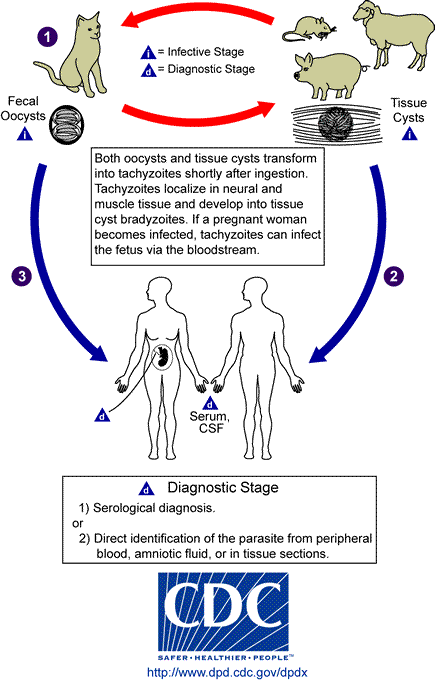Toxoplasma gondii: Difference between revisions
imported>Zahava Rubel |
imported>Zahava Rubel |
||
| Line 24: | Line 24: | ||
==Structure== | ==Structure== | ||
===Cell Structure=== | ===Cell Structure=== | ||
''T. gondii'' is a unicellular protist with an amorphous amoeboid-like body form. They have no flagella or other motility structures but move by amoeboid motion. The plasma membrane is surrounded by a cell wall. Although they do not have a contractile vesicle they have alveoli just below their plasma membrane. These alveoli are subcellular cavities characteristic of many protists that are important for stabilization of the cellular surface. The apical end of their spores contains a mass of organelles that help the spores invade their host tissue. | |||
===Genome structure=== | ===Genome structure=== | ||
Revision as of 12:03, 8 April 2009
For the course duration, the article is closed to outside editing. Of course you can always leave comments on the discussion page. The anticipated date of course completion is May 21, 2009. One month after that date at the latest, this notice shall be removed. Besides, many other Citizendium articles welcome your collaboration! |
| Toxoplasma gondii |
|---|
| Scientific classification |
|
|
Description and significance
Toxoplasma gondii is a single celled organism that is known for being the cause of Toxoplasmosis, a common food born illness.
Structure
Cell Structure
T. gondii is a unicellular protist with an amorphous amoeboid-like body form. They have no flagella or other motility structures but move by amoeboid motion. The plasma membrane is surrounded by a cell wall. Although they do not have a contractile vesicle they have alveoli just below their plasma membrane. These alveoli are subcellular cavities characteristic of many protists that are important for stabilization of the cellular surface. The apical end of their spores contains a mass of organelles that help the spores invade their host tissue.
Genome structure
The complete circular T. gondii genome was sequenced by The University of Pennsylvania in 2006. The size of the genome is 34,996nt long. Fifty two percent of the genome codes for proteins. Of the 63 genes, 26 code for proteins and 37 encode structural RNAs. Additionally the genome has a GC content of twenty one percent.
Follow this link to view the complete genome structure of T. gondii.
[1]
